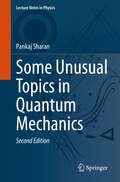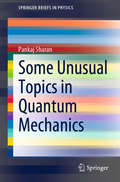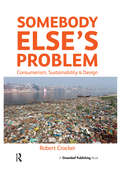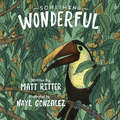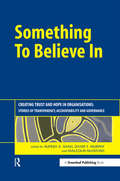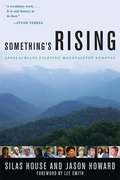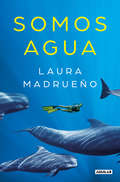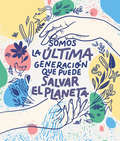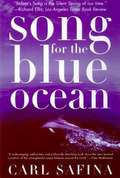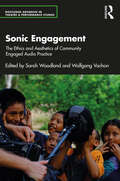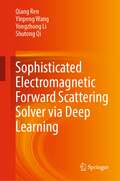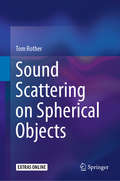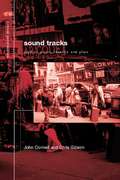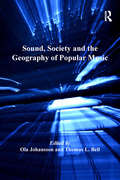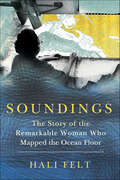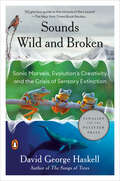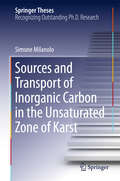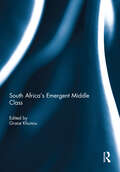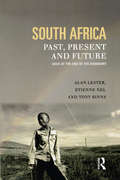- Table View
- List View
Some Unusual Topics in Quantum Mechanics (Lecture Notes in Physics #1020)
by Pankaj SharanThis second edition of Some Unusual Topics in Quantum Mechanics builds upon the topics covered in the first, with additional chapters that delve deeper into the mathematical foundations of the subject. New topics include Hilbert spaces and unbounded operators, minimum uncertainty states, path integrals in general coordinates, Fock spaces, second quantization, relativistic particle states, and quantum fields. Historical insights are also included, such as a pre-history of matrix mechanics and Pauli's proof of the H-atom spectrum using O(4) symmetry. Finally, readers are introduced to Bell's inequality and the non-locality in quantum mechanics that is revealed through its violation. These topics are rarely covered in introductory textbooks but are crucial to developing a student's interest and deeper understanding of quantum mechanics. This book serves as valuable supporting material for graduate-level core courses on the subject.
Some Unusual Topics in Quantum Mechanics (SpringerBriefs in Physics)
by Pankaj SharanIn this book, the author addresses selected topics in quantum mechanics that are not usually covered in books, but which are very helpful in developing a student's interest in, and a deeper understanding of the subject. The topics include two different ways of looking at quantum mechanics; three clarifying topics that students often find confusing; one classic theorem never proved in the classroom; and a discussion on whether there can be a non-linear quantum mechanics. The book can be used as supporting material for graduate-level core courses on quantum mechanics.
Somebody Else’s Problem: Consumerism, Sustainability and Design
by Robert CrockerGold winner of the AXIOM Business Book Award in the category of Philanthropy, Non-Profit, Sustainability. Please see: http://www.axiomawards.com/77/award-winners/2017-winners Consumerism promises a shortcut to a 'better' life through the accumulation of certain fashionable goods and experiences. Over recent decades, this has resulted in a rising tide of cheap, short-lived goods produced, used and discarded in increasingly rapid cycles, along the way depleting resources and degrading environmental systems.Somebody Else’s Problem calls for a radical change in how we think about our material world, and how we design, make and use the products and services we need. Rejecting the idea that individuals alone are responsible for the environmental problems we face, it challenges us to look again at the systems, norms and values we take for granted in daily life, and their cumulative role in our environmental crisis.Robert Crocker presents an overview of the main forces giving rise to modern consumerism, looks closely at today’s accelerating consumption patterns and asks why older, more ‘custodial’ patterns of consumption are in decline. Avoiding simplistic quick-fix formulas, the book explores recommendations for new ways of designing, making and using goods and services that can reduce our excess consumption, but still contribute to a good and meaningful life.
Something Wonderful: A Rainforest Tree And Its Fascinating Environment
by Matt RitterFrom one tiny fig seed, journey into a world of rainforest ecology This educational and interactive picture book immerses the reader in the strange and interwoven lifecycles of the rainforest. The beautifully illustrated pages follow the journey of a fig seedling making its own roots and leaves, growing strong, and eventually replacing the giant tree that was its host. As it produces flowers and fruit, it attracts pollinators. A delectable fig is hungrily eaten by a passing toucan who, upon flight, aimlessly drops a seed into the treetops below, beginning the fig’s lifecycle once again. Readers will discover additional scientific information about the pollination process, insects, and animals in an illustrated section at the end of the book, and can play a &“seek and find&” game by locating the elusive red-eyed tree frog on each page of the story. With its engaging style and abundant imagery, Something Wonderful teaches the interdependence of rainforest ecology in an easy-to-follow, captivating story.
Something to Believe In: Creating Trust and Hope in Organisations: Stories of Transparency, Accountability and Governance
by Malcolm McIntosh Rupesh A. Shah David F. MurphyIn a world where trust in politicians, corporations and the processes that determine our lives continues to dwindle, this innovative book brings together research, case studies and stories that begin to answer a central question for society: How we can create organisations, institutions, groups and societies that can nurture trusting relationships with one another and among individuals?Something to Believe In provides a fresh take on the corporate responsibility debate, based as it is on the work of key global thinkers on corporate social responsibility, along with a raft of work developed from collaborations between the New Academy of Business and the United Nations Volunteers, UK Department for International Development and TERI-Europe in countries such as Brazil, Nicaragua, Ghana, India, Sri Lanka, Bangladesh, Lebanon, Nigeria, the Philippines and South Africa. The focus is on business, and particularly how deeper, more systemic changes to current ways of understanding and undertaking business can and have been enacted in both developed countries and in nations where the Western concept of CSR means nothing. The market-based model of economic thinking-the increasingly distrusted globalisation project-which threatens to sweep all before it is challenged by many of the contributions to this book.The book tells stories such as the mobilization of civil society in Ghana to bring business to account; the reorientation of a business school to focus on values; the life-cycle of ethical chocolate; the accountability of the diamond business in a war zone; the need to reinvent codes of conduct for women workers in the plantations and factories of Nicaragua; a Philippine initiative to economically empower former Moslem liberation fighters; and the development of local governance practices in a South African eco-village.The book is split into four sections. "Through Some Looking Glasses" contains short, thought-provoking pieces about the issues of trust, belief and change from writers including Thabo Mbeki, Malcolm McIntosh and a reprinted piece from E.M. Forster. Section Two asks how it will be possible to believe in our corporations and provides new approaches from around the world on how space is being opened up to found businesses that are able to create trust. Section Three examines the role of auditing in fostering trust. Corporations continue to attempt to engender trust through their activities in philanthropy, reporting and voluntary programmes. But, post-Enron et al., even the most highly praised corporate mission statements are tarnished. Can social and environmental audits of corporate reports, codes and practices assuage our doubts about boardroom democracy? Section Four examines alternative forms of accountability, transparency and governance from around the world and offers some different ways of thinking about the practice of creating trust in society.Something to Believe In provides a host of fascinating suggestions about redefining and renewing the underlying deal between society and its organizations. It will become a key text for students, thinkers and practitioners in the field of corporate responsibility.
Something's Rising: Appalachians Fighting Mountaintop Removal
by Silas House Jason HowardLike an old-fashioned hymn sung in rounds, Something's Rising gives a stirring voice to the lives, culture, and determination of the people fighting the destructive practice of mountaintop removal in the coalfields of central Appalachia. Each person's story, unique and unfiltered, articulates the hardship of living in these majestic mountains amid the daily desecration of the land by the coal industry because of America's insistence on cheap energy. Developed as an alternative to strip mining, mountaintop removal mining consists of blasting away the tops of mountains, dumping waste into the valleys, and retrieving the exposed coal. This process buries streams, pollutes wells and waterways, and alters fragile ecologies in the region. The people who live, work, and raise families in central Appalachia face not only the physical destruction of their land but also the loss of their culture and health in a society dominated by the consequences of mountaintop removal. Included here are oral histories from Jean Ritchie, "the mother of folk," who doesn't let her eighty-six years slow down her fighting spirit; Judy Bonds, a tough-talking coal-miner's daughter; Kathy Mattea, the beloved country singer who believes cooperation is the key to winning the battle; Jack Spadaro, the heroic whistle-blower who has risked everything to share his insider knowledge of federal mining agencies; Larry Bush, who doesn't back down even when speeding coal trucks are used to intimidate him; Denise Giardina, a celebrated writer who ran for governor to bring attention to the issue; and many more. The book features both well-known activists and people rarely in the media. Each oral history is prefaced with a biographical essay that vividly establishes the interview settings and the subjects' connections to their region. Written and edited by native sons of the mountains, this compelling book captures a fever-pitch moment in the movement against mountaintop removal. Silas House and Jason Howard are experts on the history of resistance in Appalachia, the legacy of exploitation of the region's natural resources, and area's unique culture and landscape. This lyrical and informative text provides a critical perspective on a powerful industry. The cumulative effect of these stories is stunning and powerful. Something's Rising will long stand as a testament to the social and ecological consequences of energy at any cost and will be especially welcomed by readers of Appalachian studies, environmental science, and by all who value the mountain's majesty-- our national heritage.
Somos agua
by Laura MadrueñoLa periodista y presentadora Laura Madrueño nos ofrece una imprescindible lección de amor a la naturaleza y una reflexión sobre la necesidad de protegernos preservando nuestros océanos. El ser humano siempre ha sentido una gran fascinación por los océanos. La conexión es inevitable porque, más allá de ser humanos, somos agua. Sin embargo, hemos explorado más el espacio exterior que los misterios ocultos en las profundidades de nuestro planeta. Este libro nos invita a descubrir la belleza de ese universo onírico y salvaje tan cercano pero tan desconocido para muchos: el mundo submarino. En sus páginas también habla de cómo hemos contaminado más en los últimos cien años que en toda nuestra historia, haciendo que los fondos del mar se degraden muy peligrosamente por tres grandes problemas: el calentamiento climático antropogénico, el consumo masivo de plásticos y la sobrepesca de especies fundamentales para el equilibrio marino como los tiburones. Laura Madrueño, además de periodista y presentadora de El Tiempo en Telecinco, es una defensora de los mares y en este libro relata sus aventuras como submarinista y documentalista marina, nos conciencia sobre la necesidad imperiosa de realizar un cambio consciente para cuidar nuestros fondos y nos da todas las herramientas para empezar a hacerlo, compartiendo su cuaderno de bitácora con magníficas fotografías e ilustraciones para darnos a conocer nuestro gran azul. Reseñas: «Duele y emociona leer este volumen de Laura Madrueño. Lo que hemos hecho con el planeta tierra es estremecedor... Lo que podemos hacer para cambiar las cosas es grandioso. Hagamos que sea posible».Pedro Piqueras «Si el mar se pudiera leer sería este libro. Laura nos sumerge en sus profundidades a través de cuidadas fotografías y dibujos que abruman por su belleza. Nos muestra su grandeza y nos lanza un grito de socorro».Sonsoles Ónega «Laura Madrueño no ha escrito un libro, ha creado un verdadero bautismo de mar en 3 inmersiones: la pasión de una vida, la emergencia de un planeta y la responsabilidad de cada cual. De esos libros que te cambian, amplían y profundizan en la percepción de las cosas. Después de leerlo, no mojarse ya no es opción».Risto Mejide
Somos la última generación que puede salvar el planeta
by Varias autoras Carlota BrunaSomos la última generación que puede salvar el mundo y a la que las futuras generaciones mirarán a los ojos y dirán: «Y tú, ¿qué hiciste?». Carlota Bruna prologa y edita este alegato a cinco voces a favor del medioambiente, porque sí que estamos a tiempo de salvar el planeta, pero no hay más tiempo que perder. Como tú, estas cinco autoras saben que nuestra generación tiene la última oportunidad para darle la vuelta a la historia y se han propuesto hacer todo lo que esté en su mano para conseguirlo. Ellas no van a quedarse mirando. ¿Y tú? Un manifiesto con las voces de:Carlota Bruna @carlotabruna (Barcelona, 1997), estudiante de Nutrición y Dietética, autora de Camino a un mundo vegano y activista por el medioambiente y por los derechos de los animales. Connie Isla @coisla (Buenos Aires, 1994), cantautora, actriz, autora y activista vegana a favor de los derechos de los animales. Monica Rosquillas @monicarosquillas (San Diego, 1986), bloguera de girlforacleanworld.com, aventurera y activista por la sostenibilidad ambiental, económica y social. Claudia Ayuso @claudiaayuso (Madrid, 1995), autora y activista, ha presentado una serie de ocho mini documentales para Greenpeace y es la host y productora de su podcast en inglés The Cheeky Revolution, co-fundadora de El Intercambio. Patricia Ramos @PatiRamosGlez (Madrid, 2000), estudiante de Medicina y portavoz en la Cumbre Juvenil sobre el Clima de Naciones Unidas. Mariana Matija @marianamatija (Medellín, 1984), diseñadora, autora, oradora en TEDxColombia y fundadora del colectivo ecologista Hola Eco.
Song for the Blue Ocean: Encounters Along the World's Coasts and Beneath the Seas
by Carl SafinaPart odyssey, part pilgrimage, this epic personal narrative follows the author's exploration of coasts, islands, reefs, and the sea's abyssal depths. Scientist and fisherman Carl Safina takes readers on a global journey of discovery, probing for truth about the world's changing seas, deftly weaving adventure, science, and political analysis.
Sonic Engagement: The Ethics and Aesthetics of Community Engaged Audio Practice (Routledge Advances in Theatre & Performance Studies)
by Sarah Woodland Wolfgang VachonSonic Engagement examines the relationship between community engaged participatory arts and the cultural turn towards audio, sound, and listening that has been referred to as the 'sonic turn'. This edited collection investigates the use of sound and audio production in community engaged participatory arts practice and research. The popularity of podcast and audio drama, combined with the accessibility and portability of affordable field recording and home studio equipment, makes audio a compelling mode of participatory creative practice. This book maps existing projects occurring globally through a series of case study chapters that exemplify community engaged creative audio practice. The studies focus on audio and sound-based arts practices that are undertaken by artists and arts-led researchers in collaboration with (and from within) communities and groups. These practices include—applied audio drama, community engaged podcasting, sound and verbatim theatre, participatory sound art, community-led acoustic ecology, sound and media walks, digital storytelling, oral history and reminiscence, and radio drama in health and community development. The contributors interrogate the practical, political, and aesthetic potentialities of using sound and audio in community engaged arts practice, as well as its tensions and possibilities as an arts-led participatory research methodology. This book provides the first extensive analysis of what sound and audio brings to participatory, interdisciplinary, arts-led approaches, representing a vital resource for community arts, performance practice, and research in the digital age.
Sonora: Its Geographical Personality
by Robert C. WestThis cultural and historical geography of Sonora explores the region&’s dual personality—with modern life existing alongside its colonial past.A land where some streams ran with gold. A landscape nearly empty of inhabitants in the wake of Apache raids from the north. And a former desert transformed by irrigation into vast fields of wheat and cotton. This was and is the state of Sonora in northwest Mexico.Robert C. West explores the dual geographic "personality" of this part of Mexico's northern frontier. Utilizing the idea of "old" and "new" landscapes, he describes two Sonoras—to the east, a semiarid to subhumid mountainous region that reached its peak of development in the colonial era; and, to the west, a desert region that has become a major agricultural producer and the modern center of economic and cultural activity. After a description of the physical and biotic aspects of Sonora, West describes the aboriginal farming cultures that inhabited eastern Sonora before the Spanish conquest. He then traces the spread of Jesuit missions and Spanish mining and ranching communities. He charts the decline of eastern Sonora with the coming of Apache and Seri raids during the eighteenth and nineteenth centuries. And he shows how western Sonora became one of Mexico's most powerful political and economic entities in the twentieth century.
Sonora: Its Geographical Personality
by Robert C. WestThis cultural and historical geography of Sonora explores the region&’s dual personality—with modern life existing alongside its colonial past.A land where some streams ran with gold. A landscape nearly empty of inhabitants in the wake of Apache raids from the north. And a former desert transformed by irrigation into vast fields of wheat and cotton. This was and is the state of Sonora in northwest Mexico.Robert C. West explores the dual geographic "personality" of this part of Mexico's northern frontier. Utilizing the idea of "old" and "new" landscapes, he describes two Sonoras—to the east, a semiarid to subhumid mountainous region that reached its peak of development in the colonial era; and, to the west, a desert region that has become a major agricultural producer and the modern center of economic and cultural activity. After a description of the physical and biotic aspects of Sonora, West describes the aboriginal farming cultures that inhabited eastern Sonora before the Spanish conquest. He then traces the spread of Jesuit missions and Spanish mining and ranching communities. He charts the decline of eastern Sonora with the coming of Apache and Seri raids during the eighteenth and nineteenth centuries. And he shows how western Sonora became one of Mexico's most powerful political and economic entities in the twentieth century.
Sophisticated Electromagnetic Forward Scattering Solver via Deep Learning
by Qiang Ren Yinpeng Wang Yongzhong Li Shutong QiThis book investigates in detail the deep learning (DL) techniques in electromagnetic (EM) near-field scattering problems, assessing its potential to replace traditional numerical solvers in real-time forecast scenarios. Studies on EM scattering problems have attracted researchers in various fields, such as antenna design, geophysical exploration and remote sensing. Pursuing a holistic perspective, the book introduces the whole workflow in utilizing the DL framework to solve the scattering problems. To achieve precise approximation, medium-scale data sets are sufficient in training the proposed model. As a result, the fully trained framework can realize three orders of magnitude faster than the conventional FDFD solver. It is worth noting that the 2D and 3D scatterers in the scheme can be either lossless medium or metal, allowing the model to be more applicable. This book is intended for graduate students who are interested in deep learning with computational electromagnetics, professional practitioners working on EM scattering, or other corresponding researchers.
Sound Scattering on Spherical Objects
by Tom RotherThis book introduces readers to scattering from a practical/numerical point of view. The focus is on basic aspects like single scattering, multiple scattering, and whether inhomogeneous boundary conditions or inhomogeneous scatterers have to be taken into account. The powerful T-matrix approach is explained in detail and used throughout the book, and iterative solution methods are discussed. In addition, the book addresses appropriate criteria for estimating the accuracy of numerical results, as well as their importance for practical applications. Python code is provided with each chapter, and can be freely used and modified by readers. Moreover, numerous scattering results for different configurations are provided for benchmarking purposes. The book will be particularly valuable for those readers who plan to develop their own scattering code, and wish to test the correct numerical implementation of the underlying mathematics.
Sound Tracks: Popular Music Identity and Place (Critical Geographies)
by Chris Gibson John ConnellSound Tracks is the first comprehensive book on the new geography of popular music, examining the complex links between places, music and cultural identities. It provides an interdisciplinary perspective on local, national and global scenes, from the 'Mersey' and 'Icelandic' sounds to 'world music', and explores the diverse meanings of music in a range of regional contexts.In a world of intensified globalisation, links between space, music and identity are increasingly tenuous, yet places give credibility to music, not least in the 'country', and music is commonly linked to place, as a stake to originality, a claim to tradition and as a marketing device. This book develops new perspectives on these relationships and how they are situated within cultural and geographical thought.
Sound, Society and the Geography of Popular Music
by Thomas L. BellPopular music is a cultural form much rooted in space and place. This book interprets the meaning of music from a spatial perspective and, in doing so it furthers our understanding of broader social relations and trends, including identity, attachment to place, cultural economies, social activism and politics. The book's editors have brought together a team of scholars to discuss the latest innovative thinking on music and its geographies, illustrated with a fascinating range of case studies from the USA, Canada, the Caribbean, Australia and Great Britain.
Soundings: The Story of the Remarkable Woman Who Mapped the Ocean Floor
by Hali Felt“A fascinating account of a woman working without much recognition . . . to map the ocean floor and change the course of ocean science.” —San Francisco ChronicleSoundings is the story of the enigmatic woman behind one of the greatest achievements of the 20th century. Before Marie Tharp, geologist and gifted draftsperson, the whole world, including most of the scientific community, thought the ocean floor was a vast expanse of nothingness. In 1948, at age 28, Marie walked into the geophysical lab at Columbia University and practically demanded a job. The scientists at the lab were all male. Through sheer willpower and obstinacy, Marie was given the job of interpreting the soundings (records of sonar pings measuring the ocean’s depths) brought back from the ocean-going expeditions of her male colleagues. The marriage of artistry and science behind her analysis of this dry data gave birth to a major work: the first comprehensive map of the ocean floor, which laid the groundwork for proving the then-controversial theory of continental drift.Marie’s scientific knowledge, her eye for detail and her skill as an artist revealed not a vast empty plane, but an entire world of mountains and volcanoes, ridges and rifts, and a gateway to the past that allowed scientists the means to imagine how the continents and the oceans had been created over time.Hali Felt brings to vivid life the story of the pioneering scientist whose work became the basis for the work of others scientists for generations to come.“Felt’s enthusiasm for Tharp reaches the page, revealing Tharp, who died in 2006, to be a strong-willed woman living according to her own rules.” —The Washington Post
Sounds Wild and Broken: Sonic Marvels, Evolution's Creativity, and the Crisis of Sensory Extinction
by David George Haskell&“A symphony, filled with the music of life.&” —Elizabeth Kolbert, author of The Sixth ExtinctionA lyrical exploration of the diverse sounds of our planet, the creative processes that produced these marvels, and the perils that sonic diversity now facesWe live on a planet alive with song, music, and speech. David Haskell explores how these wonders came to be. In rain forests shimmering with insect sound and swamps pulsing with frog calls we learn about evolution&’s creative powers. From birds in the Rocky Mountains and on the streets of Paris, we discover how animals learn their songs and adapt to new environments. Below the waves, we hear our kinship to beings as different as snapping shrimp, toadfish, and whales. In the startlingly divergent sonic vibes of the animals of different continents, we experience the legacies of plate tectonics, the deep history of animal groups and their movements around the world, and the quirks of aesthetic evolution. Starting with the origins of animal song and traversing the whole arc of Earth history, Haskell illuminates and celebrates the emergence of the varied sounds of our world. In mammoth ivory flutes from Paleolithic caves, violins in modern concert halls, and electronic music in earbuds, we learn that human music and language belong within this story of ecology and evolution. Yet we are also destroyers, now silencing or smothering many of the sounds of the living Earth. Haskell takes us to threatened forests, noise-filled oceans, and loud city streets, and shows that sonic crises are not mere losses of sensory ornament. Sound is a generative force, and so the erasure of sonic diversity makes the world less creative, just, and beautiful. The appreciation of the beauty and brokenness of sound is therefore an important guide in today&’s convulsions and crises of change and inequity. Sounds Wild and Broken is an invitation to listen, wonder, belong, and act.
Source Mechanisms of Earthquakes: Theory and Practice
by Elisa Buforn Agustín Udías Agustín Udías Raúl Madariaga Raúl MadariagaThis book presents an innovative new approach to studying source mechanisms of earthquakes, combining theory and observation in a unified methodology, with a key focus on the mechanics governing fault failures. It explains source mechanisms by building from fundamental concepts such as the equations of elasticity theory to more advanced problems including dislocation theory, kinematic models and fracture dynamics. The theory is presented first in student-friendly form using consistent notation throughout, and with full, detailed mathematical derivations that enable students to follow each step. Later chapters explain the widely-used practical modelling methods for source mechanism determination, linking clearly to the theoretical foundations, and highlighting the processing of digital seismological data. Providing a unique balance between application techniques and theory, this is an ideal guide for graduate students and researchers in seismology, tectonophysics, geodynamics and geomechanics, and a valuable practical resource for professionals working in seismic hazard assessment and seismic engineering.
Source-to-Sink Fluxes in Undisturbed Cold Environments
by Beylich, Achim A. and Dixon, John C. and Zwoliński, Zbigniew Achim A. Beylich John C. Dixon Zbigniew ZwolińskiAmplified climate change and ecological sensitivity of polar and cold climate environments are key global environment issues. Understanding how projected climate change will alter surface environments in these regions is only possible when present day source-to-sink fluxes can be quantified. The book provides the first global synthesis and integrated analysis of environmental drivers and quantitative rates of solute and sedimentary fluxes in cold environments, and the likely impact of projected climate change. The focus on largely undisturbed cold environments allows ongoing climate change effects to be detected and, moreover, distinguished from anthropogenic impacts. A novel approach for co-ordinated and integrative process geomorphic research is introduced to enable better comparison between studies. This highly topical and multidisciplinary book, which includes case studies covering Arctic, Antarctic, and alpine environments, will be of interest to graduate students and researchers in the fields of geomorphology, sedimentology and global environmental change.
Sources and Transport of Inorganic Carbon in the Unsaturated Zone of Karst
by Simone MilanoloThis book combines field, laboratory and modelling methods to identify, characterize and quantify sources and fluxes within and between the different compartments: water, rock and air. Inorganic carbon plays an important role in shaping karst features. In the unsaturated zone, the percolating water consumes soil-derived carbon dioxide while dissolving carbonate bedrock and then releases it again while degassing and precipitating calcite in caves. A portion of the released CO2 is returned to the atmosphere through the natural ventilation of caves. This book is an important reference source for all those interested in the global carbon budget, karst geochemistry, cave climate and paleoclimate studies using cave speleothem as proxies.
Sources of Uncertainty in the Tropical Pacific Warming Pattern under Global Warming Projected by Coupled Ocean-Atmosphere Models (Springer Theses)
by Jun YingThis book discusses the sources of uncertainty in future model projections of the tropical Pacific SST warming pattern under global warming. It mainly focuses on cloud radiation feedback and ocean dynamical effect, which reveal to be the two greatest sources of uncertainty in the tropical Pacific SST warming pattern. Moreover, the book presents a correction for model projections of the tropical Pacific SST warming pattern based on the concept of “observational constraints”; the corrected projection exhibits a more El Niño-like warming pattern.
Sources, Sinks and Sustainability
by Jianguo Liu Vanessa Hull Anita T. Morzillo John A. WiensSource-sink theories provide a simple yet powerful framework for understanding how the patterns, processes and dynamics of ecological systems vary and interact over space and time. Integrating multiple research fields, including population biology and landscape ecology, this book presents the latest advances in source-sink theories, methods and applications in the conservation and management of natural resources and biodiversity. The interdisciplinary team of authors uses detailed case studies, innovative field experiments and modeling, and comprehensive syntheses to incorporate source-sink ideas into research and management, and explores how sustainability can be achieved in today's increasingly fragile human-dominated ecosystems. Providing a comprehensive picture of source-sink research as well as tangible applications to real world conservation issues, this book is ideal for graduate students, researchers, natural-resource managers and policy makers.
South Africa's Emergent Middle Class
by Grace KhunouThis book is drawn from diverse studies that grapple with Black Middle Class experiences in contemporary and historical South Africa. The chapters present research from diverse disciplines, and tackle issues related to being black and middle class, using both quantitative and qualitative approaches. Like many other social phenomena, the black middle class concept is seen as complex and not easy to pin down. As a result, conceptualizations from these chapters are dynamic and relevant for understanding the position of the black middle class in contemporary South African society. An interesting dynamic explored by contributors is the critical engagement with the usually reductionist notions of black middle class experiences as ahistorical, homogenous experiences of a group of conspicuous consumers. These limiting notions are unpacked and repositioned in how the book is structured. This book was published as a special issue of Development Southern Africa.
South Africa, Past, Present and Future: Gold at the End of the Rainbow?
by Tony Binns Alan Lester Etienne NelThis is the first book to combine a discussion of post-apartheid development initiatives with an extended historical analysis of South Africa's dynamic race, class, gender and ethnic identities. Bringing together the research of an historical geographer and two development geographers, the book enables us to locate the post-apartheid transition in a broad historical and spatial perspective. Within this perspective, the limitations as well as the achievements of South Africa's current transformation are highlighted.
